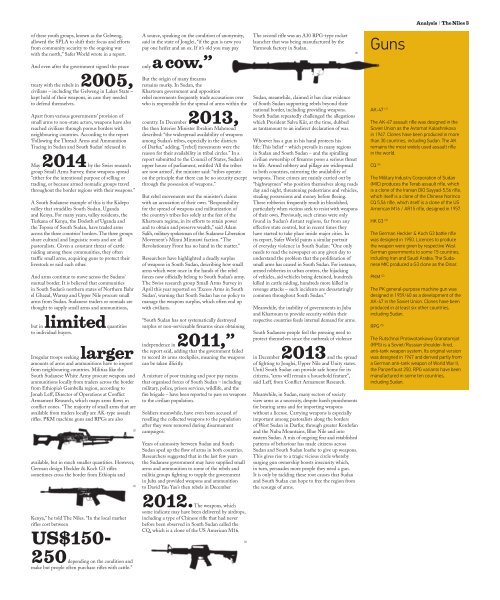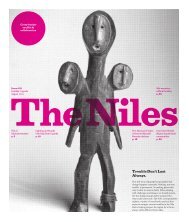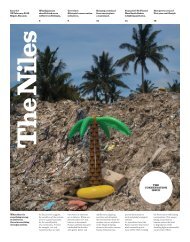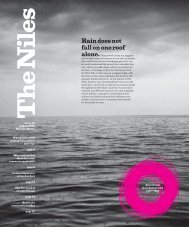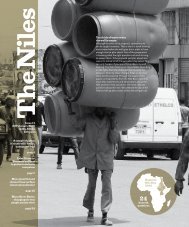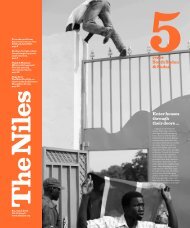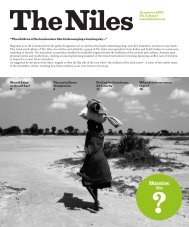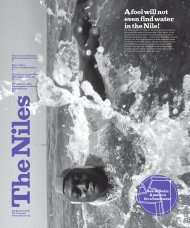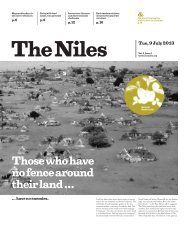If the evil is coming, shut the door...
Approximately three million small arms are circulating in Sudan and South Sudan. In the fourth edition of The Niles, our correspondents from both countries take a closer look: Where do the weapons come from? What societal role do they play? But most importantly: How many weapons are needed to establish peace and to ensure that the door on evil no longer has to be shut, as the above proverb suggests? A Darfuri fighter (photo), has a practical answer – a collection of talismans meant to protect him from bullets. But will it protect him from the person with his finger on the trigger? Albert Einstein, whose Theory of Relativity was proven in a 1952 experiment carried out in Sudan said: “The world will not be threatened by evil people rather by people who permit it.” Those words ring true here and will hopefully open another door and allow something good to slip in.
Approximately three million small arms are circulating in Sudan and South Sudan. In the fourth edition of The Niles, our correspondents from both countries take a closer look: Where do the weapons come from? What societal role do they play? But most importantly: How many weapons are needed to establish peace and to ensure that the door on evil no longer has to be shut, as the above proverb suggests? A Darfuri fighter (photo), has a practical answer – a collection of talismans meant to protect him from bullets. But will it protect him from the person with his finger on the trigger? Albert Einstein, whose Theory of Relativity was proven in a 1952 experiment carried out in Sudan said: “The world will not be threatened by evil people rather by people who permit it.” Those words ring true here and will hopefully open another door and allow something good to slip in.
You also want an ePaper? Increase the reach of your titles
YUMPU automatically turns print PDFs into web optimized ePapers that Google loves.
Analys<strong>is</strong> | The Niles 3<br />
of <strong>the</strong>se youth groups, known as <strong>the</strong> Gelweng,<br />
allowed <strong>the</strong> SPLA to shift <strong>the</strong>ir focus and efforts<br />
from community security to <strong>the</strong> ongoing war<br />
with <strong>the</strong> north,” Safer World wrote in a report.<br />
And even after <strong>the</strong> government signed <strong>the</strong> peace<br />
treaty with <strong>the</strong> rebels in 2005,<br />
civilians – including <strong>the</strong> Gelweng in Lakes State –<br />
kept hold of <strong>the</strong>ir weapons, in case <strong>the</strong>y needed<br />
to defend <strong>the</strong>mselves.<br />
Apart from various governments’ prov<strong>is</strong>ion of<br />
small arms to non-state actors, weapons have also<br />
reached civilians through porous borders with<br />
neighbouring countries. According to <strong>the</strong> report<br />
‘Following <strong>the</strong> Thread: Arms and Ammunition<br />
Tracing in Sudan and South Sudan’ released in<br />
May 2014 by <strong>the</strong> Sw<strong>is</strong>s research<br />
group Small Arms Survey, <strong>the</strong>se weapons spread<br />
“ei<strong>the</strong>r for <strong>the</strong> intentional purpose of selling or<br />
trading, or because armed nomadic groups travel<br />
throughout <strong>the</strong> border regions with <strong>the</strong>ir weapons.”<br />
A South Sudanese example of th<strong>is</strong> <strong>is</strong> <strong>the</strong> Kidepo<br />
valley that straddles South Sudan, Uganda<br />
and Kenya. For many years, valley residents, <strong>the</strong><br />
Turkana of Kenya, <strong>the</strong> Dodoth of Uganda and<br />
<strong>the</strong> Toposa of South Sudan, have traded arms<br />
across <strong>the</strong> three countries’ borders. The three groups<br />
share cultural and lingu<strong>is</strong>tic roots and are all<br />
pastoral<strong>is</strong>ts. Given a constant threat of cattle<br />
raiding among <strong>the</strong>se communities, <strong>the</strong>y often<br />
traffic small arms, acquiring guns to protect <strong>the</strong>ir<br />
livestock or raid each o<strong>the</strong>r.<br />
And arms continue to move across <strong>the</strong> Sudans’<br />
mutual border. It <strong>is</strong> believed that communities<br />
in South Sudan’s nor<strong>the</strong>rn states of Nor<strong>the</strong>rn Bahr<br />
el Ghazal, Warrap and Upper Nile procure small<br />
arms from Sudan. Sudanese traders or nomads are<br />
thought to supply small arms and ammunitions,<br />
but in limited quantities<br />
to individual buyers.<br />
Irregular troops seeking larger<br />
amounts of arms and ammunitions have to import<br />
from neighbouring countries. Militias like <strong>the</strong><br />
South Sudanese White Army procure weapons and<br />
ammunitions locally from traders across <strong>the</strong> border<br />
from Ethiopia’s Gambella region, according to<br />
Jonah Leff, Director of Operations at Conflict<br />
Armament Research, which maps arms flows in<br />
conflict zones. “The majority of small arms that are<br />
available from traders locally are AK-type assault<br />
rifles. PKM machine guns and RPGs are also<br />
available, but in much smaller quantities. However,<br />
German design Heckler & Koch G3 rifles<br />
sometimes cross <strong>the</strong> border from Ethiopia and<br />
Kenya,” he told The Niles. “In <strong>the</strong> local market<br />
rifles cost between<br />
US$150-<br />
250 depending on <strong>the</strong> condition and<br />
make but people often purchase rifles with cattle.”<br />
(2)<br />
(3)<br />
A source, speaking on <strong>the</strong> condition of anonymity,<br />
said in <strong>the</strong> state of Jonglei, “if <strong>the</strong> gun <strong>is</strong> new you<br />
pay one heifer and an ox. <strong>If</strong> it’s old you may pay<br />
only a cow.”<br />
But <strong>the</strong> origin of many firearms<br />
remains murky. In Sudan, <strong>the</strong><br />
Khartoum government and opposition<br />
rebel movements frequently trade accusations over<br />
who <strong>is</strong> responsible for <strong>the</strong> spread of arms within <strong>the</strong><br />
country. In December 2013,<br />
<strong>the</strong> <strong>the</strong>n Interior Min<strong>is</strong>ter Ibrahim Mahmoud<br />
described: “<strong>the</strong> widespread availability of weapons<br />
among Sudan’s tribes, especially in <strong>the</strong> d<strong>is</strong>tricts<br />
of Darfur,” adding, “[rebel] movements were <strong>the</strong><br />
reason for <strong>the</strong>ir availability in tribal circles.” In a<br />
report submitted to <strong>the</strong> Council of States, Sudan’s<br />
upper house of parliament, entitled ‘All <strong>the</strong> tribes<br />
are now armed’, <strong>the</strong> min<strong>is</strong>ter said: “tribes operate<br />
on <strong>the</strong> principle that <strong>the</strong>re can be no security except<br />
through <strong>the</strong> possession of weapons.”<br />
But rebel movements met <strong>the</strong> min<strong>is</strong>ter’s claims<br />
with an accusation of <strong>the</strong>ir own. “Responsibility<br />
for <strong>the</strong> spread of weapons and militarization of<br />
<strong>the</strong> country’s tribes lies solely at <strong>the</strong> feet of <strong>the</strong><br />
Khartoum regime, in its efforts to retain power<br />
and to obtain and preserve wealth,” said Adam<br />
Salih, military spokesman of <strong>the</strong> Sudanese Liberation<br />
Movement’s Minni Minnawi faction. “The<br />
Revolutionary Front has no hand in <strong>the</strong> matter.”<br />
Researchers have highlighted a deadly surplus<br />
of weapons in South Sudan, describing how small<br />
arms which were once in <strong>the</strong> hands of <strong>the</strong> rebel<br />
forces now officially belong to South Sudan’s army.<br />
The Sw<strong>is</strong>s research group Small Arms Survey in<br />
April th<strong>is</strong> year reported on ‘Excess Arms in South<br />
Sudan’, warning that South Sudan has no policy to<br />
manage <strong>the</strong> weapons surplus, which often end up<br />
with civilians.<br />
“South Sudan has not systematically destroyed<br />
surplus or non-serviceable firearms since obtaining<br />
independence in 2011,”<br />
<strong>the</strong> report said, adding that <strong>the</strong> government failed<br />
to record its arms stockpiles, meaning <strong>the</strong> weapons<br />
can be taken illicitly.<br />
A mixture of poor training and poor pay means<br />
that organ<strong>is</strong>ed forces of South Sudan – including<br />
military, police, pr<strong>is</strong>on services, wildlife, and <strong>the</strong><br />
fire brigade – have been reported to pass on weapons<br />
to <strong>the</strong> civilian population.<br />
Soldiers meanwhile, have even been accused of<br />
reselling <strong>the</strong> collected weapons to <strong>the</strong> population<br />
after <strong>the</strong>y were removed during d<strong>is</strong>armament<br />
campaigns.<br />
Years of animosity between Sudan and South<br />
Sudan sped up <strong>the</strong> flow of arms in both countries.<br />
Researchers suggested that in <strong>the</strong> last few years<br />
<strong>the</strong> Sudanese government may have supplied small<br />
arms and ammunition to some of <strong>the</strong> rebels and<br />
militia groups fighting to topple <strong>the</strong> government<br />
in Juba and provided weapons and ammunition<br />
to David Yau Yau’s <strong>the</strong>n rebels in December<br />
2012. The weapons, which<br />
some indicate may have been delivered by airdrops,<br />
including a type of Chinese rifle that had never<br />
before been observed in South Sudan called <strong>the</strong><br />
CQ, which <strong>is</strong> a clone of <strong>the</strong> US American M16.<br />
(4)<br />
The second rifle was an A30 RPG-type rocket<br />
launcher that was being manufactured by <strong>the</strong><br />
Yarmouk factory in Sudan.<br />
Sudan, meanwhile, claimed it has clear evidence<br />
of South Sudan supporting rebels beyond <strong>the</strong>ir<br />
national border, including providing weapons.<br />
South Sudan repeatedly challenged <strong>the</strong> allegations<br />
which President Salva Kiir, at <strong>the</strong> time, dubbed<br />
as tantamount to an indirect declaration of war.<br />
Whoever has a gun in h<strong>is</strong> hand protects h<strong>is</strong><br />
life: Th<strong>is</strong> belief – which prevails in many regions<br />
in Sudan and South Sudan – and <strong>the</strong> spiralling<br />
civilian ownership of firearms poses a serious threat<br />
to life. Armed robbery and pillage are widespread<br />
in both countries, mirroring <strong>the</strong> availability of<br />
weapons. These crimes are mainly carried out by<br />
“highwaymen” who position <strong>the</strong>mselves along roads<br />
day and night, threatening pedestrians and vehicles,<br />
stealing possessions and money before fleeing.<br />
These robberies frequently result in bloodshed,<br />
particularly when victims seek to res<strong>is</strong>t with weapons<br />
of <strong>the</strong>ir own. Previously, such crimes were only<br />
found in Sudan’s d<strong>is</strong>tant regions, far from any<br />
effective state control, but in recent times <strong>the</strong>y<br />
have started to take place inside major cities. In<br />
its report, Safer World paints a similar portrait<br />
of everyday violence in South Sudan: “One only<br />
needs to read <strong>the</strong> newspaper on any given day to<br />
understand <strong>the</strong> problem that <strong>the</strong> proliferation of<br />
small arms has caused in South Sudan. For instance,<br />
armed robberies in urban centres, <strong>the</strong> hijacking<br />
of vehicles, aid vehicles being detained, hundreds<br />
killed in cattle raiding, hundreds more killed in<br />
revenge attacks – such incidents are devastatingly<br />
common throughout South Sudan.”<br />
Meanwhile, <strong>the</strong> inability of governments in Juba<br />
and Khartoum to provide security within <strong>the</strong>ir<br />
respective countries feeds internal demand for arms.<br />
South Sudanese people feel <strong>the</strong> pressing need to<br />
protect <strong>the</strong>mselves since <strong>the</strong> outbreak of violence<br />
in December 2013 and <strong>the</strong> spread<br />
of fighting to Jonglei, Upper Nile and Unity states.<br />
Until South Sudan can provide safe home for its<br />
citizens, “arms will remain a household feature”,<br />
said Leff, from Conflict Armament Research.<br />
Meanwhile, in Sudan, many sectors of society<br />
view arms as a necessity, despite harsh pun<strong>is</strong>hments<br />
for bearing arms and for importing weapons<br />
without a license. Carrying weapons <strong>is</strong> especially<br />
important among pastoral<strong>is</strong>ts along <strong>the</strong> borders<br />
of West Sudan in Darfur, through greater Kordofan<br />
and <strong>the</strong> Nuba Mountains, Blue Nile and into<br />
eastern Sudan. A mix of ongoing fear and establ<strong>is</strong>hed<br />
patterns of behaviour has made citizens across<br />
Sudan and South Sudan loa<strong>the</strong> to give up weapons.<br />
Th<strong>is</strong> gives r<strong>is</strong>e to a tragic vicious circle whereby<br />
surging gun ownership boosts insecurity which,<br />
in turn, persuades more people <strong>the</strong>y need a gun.<br />
It <strong>is</strong> only by tackling <strong>the</strong>se root causes that Sudan<br />
and South Sudan can hope to free <strong>the</strong> region from<br />
<strong>the</strong> scourge of arms.<br />
(5)<br />
Guns<br />
AK-47 (1)<br />
The AK-47 assault rifle was designed in <strong>the</strong><br />
Soviet Union as <strong>the</strong> Avtomat Kalashnikova<br />
in 1947. Clones have been produced in more<br />
than 30 countries, including Sudan. The AK<br />
remains <strong>the</strong> most widely used assault rifle<br />
in <strong>the</strong> world.<br />
CQ (4)<br />
The Military Industry Corporation of Sudan<br />
(MIC) produces <strong>the</strong> Terab assault rifle, which<br />
<strong>is</strong> a clone of <strong>the</strong> Iranian DIO Sayyad-5,56 rifle,<br />
which itself <strong>is</strong> a clone of <strong>the</strong> Chinese Norinco<br />
CQ 5,56 rifle, which itself <strong>is</strong> a clone of <strong>the</strong> US<br />
American M16 / AR15 rifle, designed in 1957.<br />
HK G3 (3)<br />
The German Heckler & Koch G3 battle rifle<br />
was designed in 1950. Licences to produce<br />
<strong>the</strong> weapon were given by respective West<br />
German governments to some 15 countries,<br />
including Iran and Saudi Arabia. The Sudanese<br />
MIC produced a G3 clone as <strong>the</strong> Dinar.<br />
PKM (2)<br />
The PK general-purpose machine gun was<br />
designed in 1959/60 as a development of <strong>the</strong><br />
AK-47 in <strong>the</strong> Soviet Union. Clones have been<br />
produced in at least six o<strong>the</strong>r countries,<br />
including Sudan.<br />
RPG (5)<br />
The Rutschnoi Protiwotankowy Granatomjot<br />
(RPG) <strong>is</strong> a Soviet/Russian shoulder-fired,<br />
anti-tank weapon system. Its original version<br />
was designed in 1947 and derived partly from<br />
a German anti-tank weapon of World War II,<br />
<strong>the</strong> Panzerfaust 250. RPG variants have been<br />
manufactured in some ten countries,<br />
including Sudan.


